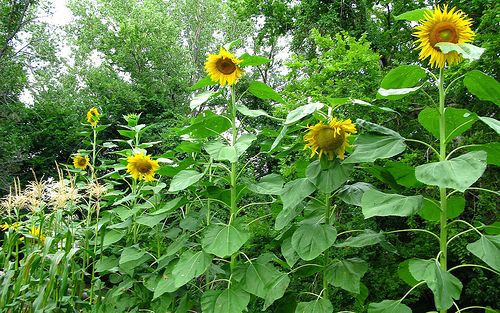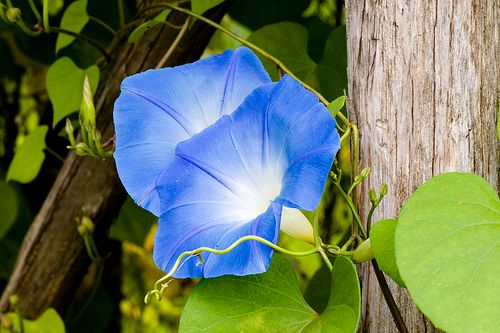
Sunflowers (Helianthus annuus) have an inherently happy disposition, with charming heads that follow the sun. They’re also quite handy for constructing houses, forts, walls, and mazes for kids. These flower homes become the perfect place to bring kids and nature together in some of the most imaginative ways. Sunflower structures are visited by butterflies galore, and the largest sunflower varieties grow leaves and flowers larger than your kid’s head! Sunflower houses are a wonderful way to get your kids into the garden.
To build one of these structures, you’ll want to plant the big-to-monster-size varieties as the main supports:
- ‘Giant Gray Stripe’—12 feet tall with 15-to-20-inch flower heads
- ‘Kong’—12 feet tall
- ‘Russian Mammoth’—10 to 12 feet tall with 12-to-24-inch flowers
- ‘Sunzilla’—10 to 16 feet tall with flowers 20 inches or more
- ‘Skyscraper’—12 feet tall with 14-inch flower heads
- ‘Paul Bunyan’—13 to 15 feet with tall 14-inch flowers
You can use other varieties of sunflower in between the stalks for color variation and for filling in:
- ‘Velvet Queen’—4 to 6 feet tall with 6-inch flowers
- ‘Autumn Beauty’—5 to 6 feet tall with 5-inch flowers
- ‘Indian Blanket’—5 to 7 feet tall with 4-to-5-inch flower heads
- ‘Lemon Queen’—7 to 8 feet tall with 4-inch flowers
Of course, you may want to embellish your sunflower house at knee-level with one of these shorter varieties:
- ‘Teddy Bear’—3 feet tall with 3-to-6-inch flowers
- ‘Sundance Kid’—1 to 2 feet tall
- ‘Dwarf Sunspot’—2 to 3 feet tall with 10-inch flower heads
- ‘Elf’—1 to 2 feet tall
The last couple of things you’ll need are morning glory seeds (Ipomoea spp.), such as my favorite, Heavenly Blue, or Grandpa Otts, and a big roll of twine, jute, or very light rope.
Build a sunflower house
The first thing you need to do is choose the site to plant the sunflower house. This area needs to get six to eight hours of sun. Sunflowers are at their best in brilliant sunshine, so the more sun the better. Most people plant a rectangle-shaped structure. Feel free to make whatever size house your kids would like or your yard can hold. To get as much light as you can on your sunflower house, you’ll want one of the short rectangular ends facing north. This step isn’t going to make or break your house, but it’s the way to get the most benefit from the daylight.
One thing that’s important to know about sunflowers, especially if you’re trying to get them to a giant size, is that they’re very heavy feeders—much like corn. So when you first sow your seeds, make a 5- or 6-inch trench along each side of the house, and fill it in well with compost or composted manure before planting the seeds. A little fertilizer while the plants are actively growing wouldn’t hurt either. The rule of thumb with seed planting is to plant it twice as deep as the seed size. It’s the same with sunflowers. This is an easy first rule for kids to remember, and sunflower seeds are the perfect size for small fingers to handle.
Plant the giant sunflower seeds first at about 6 inches apart, filling in behind or in front of those seeds with the medium-size sunflowers and finally the little guys. There’s no specific strategy when building your house other than to have the whole thing in a basic rectangular shape. Don’t forget to leave a few feet of space unplanted at one of the shorter ends to create a front door.
Soak the morning glory seeds overnight in a shallow bowl to help break through the tough outer shell. Then plant these seeds at the base of the sunflowers along the two longest sides of the house. The morning glories will now grow up the sunflower stalks.
The center (inside) of the house should have straw, grass, or some other material that’s pleasant for feet, as this is the floor of your house. Keep the trenches evenly watered, and as the bigger sunflowers grow, they may need some support such as stakes. The medium-size flowers will be supported by the giants. When the sunflowers are reaching their mature height, take the twine or jute and tie it on to the first sunflower just below the flower head. Then weave the twine throughout the top of the entire structure—making sure to go across the entire open space—like you’re attempting to sew the top together.
The idea here isn’t to pull on the flower heads, but rather to make sure it’s taut across the top of the sunflower house. When the morning glories reach the top of the sunflowers, they’ll begin to grow out onto the twine and make a beautiful blue ceiling. Don’t let the kids keep the magic for themselves. When the morning glories begin blooming, get into that sunflower house, lie on your back, and admire the glowing blue sky that you and your kids planted.
Using the same basic technique, have kids come up with their own ideas for sunflower structures such as for walls (forts) and even backyard mazes—which for some zones could still be intact for October and can then be modified with pumpkins and gourds as a Halloween maze.
For more on sunflowers, check out Kids Can Make Bird Feeders Out of Sunflower Heads and Roast Your Own Sunflower Seeds.




















Comments
Very useful article, thank you very much. I would like to build such a house for my children where they can study. It is very important to me that my daughters get a good education, so I use https://legitwritingservices.com/mba-essay-writing-services/ where I can find a lot of useful information about educational resources.
Log in or create an account to post a comment.
Sign up Log in